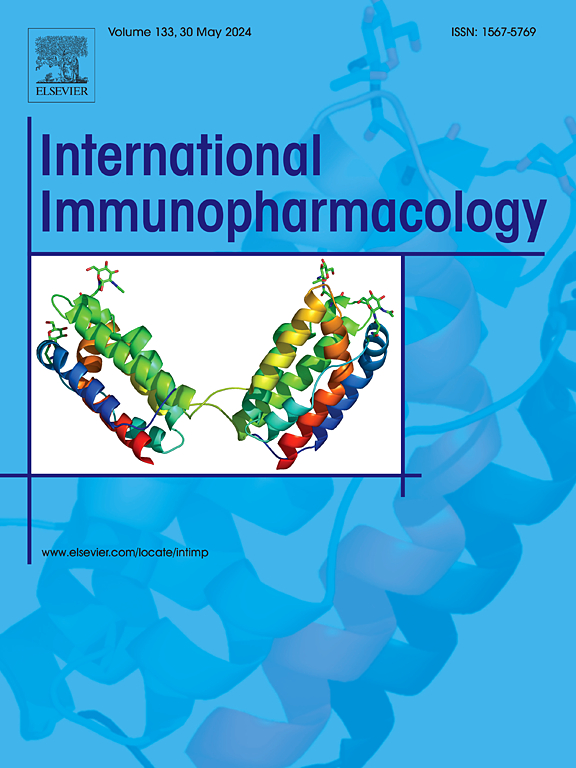Silybin attenuates microglia-mediated neuroinflammation via inhibition of STING in experimental subarachnoid hemorrhage
IF 4.7
2区 医学
Q2 IMMUNOLOGY
引用次数: 0
Abstract
Background
The primary cause of subarachnoid hemorrhage (SAH) is the rupture of intracranial aneurysms. Over-activation of microglia following SAH is a primary driving force in early brain injury (EBI), which is a leading cause of poor outcomes. Silybin is a flavonoid compound extracted from Silybum marianum, a plant belonging to the Asteraceae family. Its anti-inflammatory and antioxidant properties could provide neuroprotective effects. The mechanism of silybin on EBI after SAH is unclear.
Purpose
To determine the therapeutic effect of silybin on SAH and its underlying mechanisms.
Methods
We used a prechiasmatic autologous arterial blood injection in vivo and hemoglobin in vitro to establish experimental SAH model. Dexamethasone was used as a positive control drug. We evaluated the neuroprotective effect of silybin on the in vivo SAH model by neurological function scores, rotarod test, and open field test, and explored the protective effect of silybin on neuroinflammation and apoptosis after SAH by quantitative polymerase chain reaction (qPCR), western blot (WB), Immunofluorescence (IF) and TUNEL staining. IF staining of CD86 and CD206 was used to assess microglial phenotype polarization. Then we used WB and IF labeling of STING to explore the effect of silybin on the STING pathway after SAH, and used a combination of transcriptomics and non-targeted metabolomics to study the potential mechanism of silybin in detail, and verified the essential genes by qPCR. We also extracted cerebrospinal fluid from SAH patients and detected the expression level of STING in cerebrospinal fluid by enzyme-linked immunosorbent assay (ELISA) to clarify the association between STING and neural function.
Results
Results showed that silybin ameliorated neuronal damage and improved short-term neurological function, and reduced inflammatory damage and neuronal apoptosis in SAH mice. Silybin inhibited the expression levels of TNF-α, IL-1β and NLRP3, and promoted the expression levels of CD206, Arg1 and IL-10. Notably, Silybin promoted M2 microglia polarization. Further studies found that silybin reduced the mRNA and protein levels of the stimulator of interferon genes (STING) in microglia. And the use of a specific activator of STING (CMA) disrupted the protective effect of silybin. A total of 358 differential expression genes were identified using transcriptomics, and 150 different metabolites abundance were identified using metabolomic screening. Analysis of the effects of STING on transcriptomics and metabolomics revealed that STING might impact metabolic pathways, including linoleic acid metabolism. The qPCR results confirmed the decreased expression of essential proteins involved in the pathway. Finally, we found that increased STING expression in the cerebrospinal fluid of SAH patients was associated with decreased neurological function scores and poor prognosis.
Conclusion
Silybin had a therapeutic effect on SAH. The underlying mechanism involves linoleic acid metabolism, which is associated with the differential genes and metabolites detected in the study. This study presented a pharmacological rationale for using silybin to treat SAH.
水飞蓟宾通过抑制实验性蛛网膜下腔出血中STING减轻小胶质细胞介导的神经炎症
背景蛛网膜下腔出血(SAH)的主要原因是颅内动脉瘤破裂。SAH后小胶质细胞的过度激活是早期脑损伤(EBI)的主要驱动力,这是导致预后不良的主要原因。水飞蓟宾是一种从菊科植物水飞蓟中提取的类黄酮化合物。其抗炎和抗氧化特性可提供神经保护作用。水飞蓟宾对SAH后EBI的作用机制尚不清楚。目的探讨水飞蓟宾对SAH的治疗作用及其机制。方法采用体内交叉前自体动脉血注射法和体外血红蛋白法建立实验性SAH模型。以地塞米松作为阳性对照药物。我们通过神经功能评分、rotarod试验、开放野试验评价水飞蓟宾对体内SAH模型的神经保护作用,并通过定量聚合酶链反应(qPCR)、western blot (WB)、免疫荧光(IF)和TUNEL染色探讨水飞蓟宾对SAH后神经炎症和细胞凋亡的保护作用。CD86和CD206的IF染色用于评估小胶质细胞表型极化。然后,我们利用STING的WB和IF标记,探索水飞蓟宾对SAH后STING通路的影响,并结合转录组学和非靶向代谢组学,详细研究水飞蓟宾的潜在作用机制,并通过qPCR验证必需基因。我们还提取了SAH患者的脑脊液,用酶联免疫吸附试验(ELISA)检测脑脊液中STING的表达水平,以阐明STING与神经功能的关系。结果水飞蓟宾可改善SAH小鼠神经损伤,改善短期神经功能,减轻炎症损伤和神经元凋亡。水飞蓟宾抑制TNF-α、IL-1β和NLRP3的表达水平,促进CD206、Arg1和IL-10的表达水平。值得注意的是,水飞蓟宾促进M2小胶质细胞极化。进一步研究发现,水飞蓟宾可降低小胶质细胞中干扰素刺激基因(STING)的mRNA和蛋白水平。使用特定的STING活化剂(CMA)破坏了水飞蓟宾的保护作用。利用转录组学鉴定了358个差异表达基因,利用代谢组学筛选鉴定了150个不同的代谢物丰度。STING对转录组学和代谢组学的影响分析表明,STING可能影响代谢途径,包括亚油酸代谢。qPCR结果证实了该通路中必需蛋白的表达减少。最后,我们发现SAH患者脑脊液中STING表达增加与神经功能评分下降和预后不良相关。结论水飞蓟宾对SAH有治疗作用。潜在的机制涉及亚油酸代谢,这与研究中检测到的差异基因和代谢物有关。本研究提出了使用水飞蓟宾治疗SAH的药理学原理。
本文章由计算机程序翻译,如有差异,请以英文原文为准。
求助全文
约1分钟内获得全文
求助全文
来源期刊
CiteScore
8.40
自引率
3.60%
发文量
935
审稿时长
53 days
期刊介绍:
International Immunopharmacology is the primary vehicle for the publication of original research papers pertinent to the overlapping areas of immunology, pharmacology, cytokine biology, immunotherapy, immunopathology and immunotoxicology. Review articles that encompass these subjects are also welcome.
The subject material appropriate for submission includes:
• Clinical studies employing immunotherapy of any type including the use of: bacterial and chemical agents; thymic hormones, interferon, lymphokines, etc., in transplantation and diseases such as cancer, immunodeficiency, chronic infection and allergic, inflammatory or autoimmune disorders.
• Studies on the mechanisms of action of these agents for specific parameters of immune competence as well as the overall clinical state.
• Pre-clinical animal studies and in vitro studies on mechanisms of action with immunopotentiators, immunomodulators, immunoadjuvants and other pharmacological agents active on cells participating in immune or allergic responses.
• Pharmacological compounds, microbial products and toxicological agents that affect the lymphoid system, and their mechanisms of action.
• Agents that activate genes or modify transcription and translation within the immune response.
• Substances activated, generated, or released through immunologic or related pathways that are pharmacologically active.
• Production, function and regulation of cytokines and their receptors.
• Classical pharmacological studies on the effects of chemokines and bioactive factors released during immunological reactions.

 求助内容:
求助内容: 应助结果提醒方式:
应助结果提醒方式:


